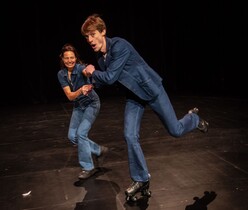Young Europe Blog: Palinkantzaroi - Miskolci Nemzeti Szìnhàz puts goblins into a classroom
Bloodbrothers
by Alissa Rubinstein
Berlin, May 14th 2013. "Palinkantzaroi" is a musical that takes place in a high school classroom in Hungary – Hungary’s answer to High School Musical, perhaps? But no… this was definitely no happy-go-lucky Disney TV movie. In fact, I knew going into the performance that the collaboration between the two theaters – the Miskolci Nemzeti Szìnhàz (Hungary) and the Cyprus Theatre Organisation – had hit some major turbulence before the two theaters ultimately decided to part ways and develop two separate plays. The Cypriots had suggested the original idea of creating a musical involving the kalinkantzaroi, mythological Cypriot goblins, and, although Hungarian director Artur Szöcs confessed after yesterday's performance to not being much of a musical fan, he went along with the idea anyway, even after communication between the two theaters broke down. Despite the best efforts of an enthusiastic cast, the Hungarian creative team's struggles with the form, plot and meaning of their play were clear from beginning to end.
As the show begins, two kalinkantzaroi are trying to find their way home and end up in this classroom instead (a classroom with a haphazard sketch of Europe on the chalkboard). Confused and homesick, they take the students hostage while they try to decide what to do. Most of the students are audience members sitting at desks arranged to look like a typical classroom. But wait! As it turns out, one of the hostage students is actually also a kalinkantzaro, who has for some reason been banished to the human world. He too wants to go home, so he joins forces with his kalinkantzaroi bloodbrothers. He prowls around the desks, menacing audience members with a giant bow and arrow and forcing female students (Hungarian high school students sitting in front of conspicuously blank-screened laptops) to contact other kalinkantzaroi for help via Facebook chat.
As a slightly obsessed, overwhelmingly proud and unapologetic devotee of the Anglo-American musical tradition, I was excited to see how Hungary would go about staging a musical. The answer? A bit awkwardly, to be honest. I wish they had dedicated themselves 100% to taking an American art form and using it to tell a Hungarian story – perhaps problem number one is that it was actually a Cypriot story, relocated to Hungary. Every once and awhile, an actor would get a mournful, determined look on his face, the overly loud, pre-recorded music would start and the audience would be treated to a nostalgic love poem to, say, Romania, emoted with great fervor by a forlorn Romanian kalinkantzaro who just wants to go home, goddammit. Don’t we all just want to go home?
Speaking of home – “Palinkantzaroi” is normally performed in a real high school classroom in Hungary for an audience of real Hungarian high school students, and I can imagine that it works a lot better in that context. The play I saw yesterday morning relies quite heavily on the interaction between actor and audience member, between terrorist goblin and hostage high school student. “Hands up!” the goblins screech. The Hungarian students probably just throw their hands in the air. Me? I suddenly have this face right in front of my face, staring deeply into my eyes and hollering in a language I can’t even begin to decipher. The owner of this face obviously wants me to do something, but in order to figure out what, I have to break eye contact, take both of us out of the theatrical moment and search for the translation flashing on a tiny screen in the front of the room.
It might sound like I had a terrible time in the theater yesterday morning. The funny thing is, I did enjoy myself, despite my constant urge to rewrite all the supertitles. The fun thing about theater is that, when you really do it right, it almost doesn’t matter if you can understand the words or not; the theatrical images speak for themselves. There were definitely moments like that in “Palinkantzaroi”: an absurdly tall actor sticking a lit match in his mouth and wiggling his eyebrows, for example, or casually demonstrating his fluency in Seagull. I only wish there had been more.
Der Blog ist ein Kooperationsprojekt von nachtkritik.de und der European Theatre Convention im Rahmen des Young Europe Festivals. Seine Inhalte sind nicht Teil des redaktionellen Kontents von nachtkritik.de: Impressum.
meldungen >
- 17. April 2024 Autor und Regisseur René Pollesch in Berlin beigesetzt
- 17. April 2024 London: Die Sieger der Olivier Awards 2024
- 17. April 2024 Dresden: Mäzen Bernhard von Loeffelholz verstorben
- 15. April 2024 Würzburg: Intendant Markus Trabusch geht
- 15. April 2024 Französischer Kulturorden für Elfriede Jelinek
- 13. April 2024 Braunschweig: LOT-Theater stellt Betrieb ein
- 13. April 2024 Theater Hagen: Neuer Intendant ernannt
- 12. April 2024 Landesbühnentage 2024 erstmals dezentral








neueste kommentare >